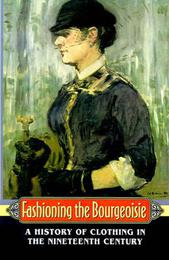
|
Fashioning the Bourgeoisie: A History of Clothing in the Nineteenth Century
Paperback / softback
Main Details
| Title |
Fashioning the Bourgeoisie: A History of Clothing in the Nineteenth Century
|
| Authors and Contributors |
By (author) Philippe Perrot
|
|
Translated by Richard Bienvenu
|
| Physical Properties |
| Format:Paperback / softback | | Pages:286 | | Dimensions(mm): Height 254,Width 197 |
|
| Category/Genre | Economic history |
|---|
| ISBN/Barcode |
9780691000817
|
| Classifications | Dewey:391.009034 |
|---|
| Audience | | Professional & Vocational | | Tertiary Education (US: College) | |
|---|
| Illustrations |
53 line illus.
|
|
Publishing Details |
| Publisher |
Princeton University Press
|
| Imprint |
Princeton University Press
|
| Publication Date |
29 December 1996 |
| Publication Country |
United States
|
Description
When department stores like Le Bon Marche first opened their doors in mid-nineteenth-century Paris, shoppers were offered more than racks of ready-made frock coats and crinolines. They were given the chance to acquire a lifestyle as well--that of the bourgeoisie. Wearing proper clothing encouraged proper behavior, went the prevailing belief. Available now for the first time in English, Fashioning the Bourgeoisie was one of the first extensive studies to explain a culture's sociology through the seemingly simple issue of the choice of clothing. Philippe Perrot shows, through a delightful tour of the rise of the ready-made fashion industry in France, how clothing can not only reflect but also inculcate beliefs, values, and aspirations. By the middle of the century, men were prompted to disdain the decadent and gaudy colors of the pre-Revolutionary period and wear unrelievedly black frock coats suitable to the manly and serious world of commerce. Their wives and daughters, on the other hand, adorned themselves in bright colors and often uncomfortable and impractical laces and petticoats, to signal the status of their family.The consumer pastime of shopping was born, as women spent their spare hours keeping up their middle-class appearance, or creating one by judicious purchases. As Paris became the fashion capital and bourgeois modes of dress and their inherent attitudes became the ruling lifestyle of Western Europe and America, clothing and its "civilizing" tendencies were imported to non-Western colonies as well. In the face of what Perrot calls this "leveling process," the upper classes tried to maintain their stature and right to elegance by supporting what became the high fashion industry. Richly detailed, entertaining, and provocative, Fashioning the Bourgeoisie reveals to us the sources of many of our contemporary rules of fashion and etiquette.
Author Biography
Philippe Perrot is Charge de Recherches at the Centre d'Etudes Transdisciplinaires de l'Ecole des Hautes Etudes en Sciences Sociales in Paris. Richard Bienvenu is Professor of History at the University of Missouri, Columbia.
Reviews"A fascinating and amusing examination of social attitudes."--The Times Literary Supplement "The overall thesis that emerges is both limpid and profound; as far as clothing is concerned, we still belong to the nineteenth century."--Liberation "[Perrot] glides through the dressing rooms and bedrooms of the Second Empire, inspects armoires, haunts the department stores and the fitting rooms of couturiers and tailors, lives with fashionable women and tarts, bankers, and 10-franc-a-month shop assistants."--Le Nouvel observateur "Perrot puts a serious and persuasive case for the importance of clothing to understanding the aesthetic and moral values of the nineteenth-century middle-class... Immensely learned, yet written with great delicacy and lightness of touch, it remains the best account available of the meaning, and eventual triumph, of the bourgeois trouser--that most resilient and universal survival of nineteenth-century Europe's dominance of the globe."--John Adamson, Sunday Telegraph "A fascinating book: not so much a history of clothing, as a history of French society seen through its fashions and its clothes."--Sharif Gemie, Modern & Contemporary France "Fashion history is not about hemlines, it is about the nuts and bolts of living. It is because he accepts this fact that Perrot's examination of a period so germane to our own is valuable."--Colin McDowell, Sunday Times (London)
|